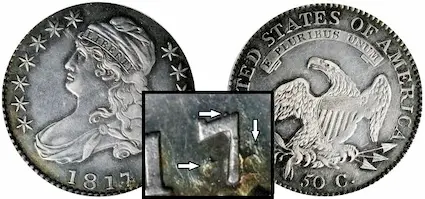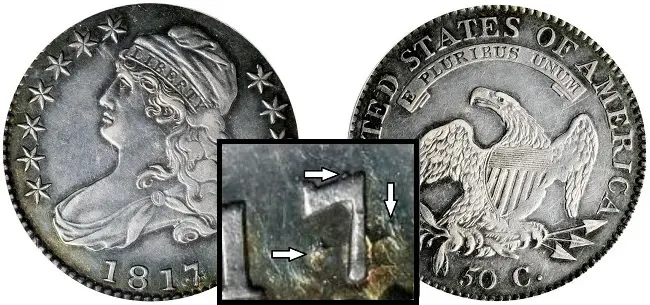1817 Capped Bust Half Dollar, 7/4
In October 1930, news broke of an amazing discovery in the world of coin collecting. It was reported in The Numismatist magazine that dealer E.T. Wallis of Los Angeles had confirmed a previously unknown variety of the 1817 Capped Bust half dollar. After 113 years, it was finally documented there was, on at least one specimen, a 4 hiding under the 7 in the 1817 date.(1)
Since then, precious few examples of the 1817/4 half dollar have surfaced, yet the hunt excitedly continues for more. The mystique, rarity, and high value of this variety have elevated it to one of the greatest coins in United States numismatics.
What was the genesis of the overdate? Why is it so rare? How come it took so long for it to be discovered? Researchers have worked diligently to piece together the history of the 1817/4 half dollar.
The War of 1812 commenced in June of that year and ended with the Battle of New Orleans in January 1815. This conflict, coinciding with the Napoleonic Wars in Europe, played havoc with the American economy, international trade, and bullion prices, all of which depressed precious metal deposits at the United States Mint in Philadelphia.(2)(3)(4)
Production of most U.S. coin denominations was halted or intermittent from 1812-1814. However, during those years, half dollar production remained strong, with mintages exceeding one million pieces annually.(5) Perhaps the Mint was expecting even higher demand for half dollars, because by 1815 three unused obverse dies were left over: one each from 1812, 1813, and 1814.(6)(7)
By 1815, silver bullion deposits hit rock bottom. No new half dollar obverse dies were made. Instead, the engraver stamped a 5 over the 2 on the 1812 die and went on to strike just 47,150 pieces. All 1815 half dollars display the 5/2 overdate.(8)
Tragedy struck in January 1816 when a fire at the Mint destroyed the rolling mills and drawing machines. That put a stop to gold and silver coinage for more than one year. In the meantime, with war no longer clouding the future, bullion deposits to the Mint increased. Because of inoperative machinery, it simply accumulated until May 1817, when new equipment was installed.(9)
The first order of business was to whittle down the bullion backlog by striking the publicly favored half dollars. Inexplicably, there were no new 1817 dies ready for production, so the leftover 1813 and 1814 dies were pulled out of storage.
The 1813 die was punched with a 7 over the 3. The 7/3 die was put into service and struck a relatively large number of half dollars, all with the overdate readily visible.
On the 1814 die, more effort was made to remove the 4 before adding the 7. They were successful, leaving just minimal traces of the 4. Researchers speculate the effacement process weakened the die and soon caused a large vertical crack, leading to premature retirement or failure of the die. The number of half dollars struck by the doomed 1817/4 die is unknown, but most certainly was very small.
There are 11 confirmed examples today of the 1817/4 Capped Bust half dollar. Normally, Rare Coins 101 does not include essentially uncollectible coins on our Key Date List of recommendations, but we made an exception for this one. Consider this: Four of the 11 known examples have been discovered since 2005.(10)
This variety has been around “only” since 1930 and is a relative newcomer to the numismatic scene. As old coin hoards are searched, verified examples continue to enter the marketplace (albeit at a slow pace). Probably more 1817/4 half dollars await detection. Now you know what to look for!
| Estimated survivors in all grades: 11 ?
The survivor estimate from PCGS represents an average of one or more experts' opinions as to how many examples survive of a particular coin in all grades. Survival estimates include coins that are raw, certified by PCGS, and certified by other grading services. Learn more at PCGS. |
| PCGS Rarity Scale: 9.5 ?
The 'PCGS CoinFacts Rarity Scale' assesses the relative rarity of all U.S. coins, based on estimated surviving examples. The scale runs from 1.0 to 10.0. The higher the number, the rarer the coin.
Learn more at PCGS. |
| Search for the 1817 Capped Bust Half Dollar, 7/4 on eBay** |
Preview of eBay selection (sorry, but you may never find an 1817/4 half dollar on eBay):
 |
|
| Trendline Avg = 8.73 | CLASSIC RARITY |
 |
|
| Trendline Avg = 8.73 | CLASSIC RARITY |
Historic Value Trend Charts:
| Last updated 5-10-25 | Return to Key Date Coin List | |
| Compare to Common Date Coin of Same Type | ||
|
|
||
| Download Charts to Your Computer | ||
Sources
1. Garrett, Jeff and Guth, Ron. 100 Greatest U.S. Coins, 5th ed. Pelham, AL: Whitman Publishing, 2019.
2. Todd, Lewis P. and Curti, Merle. Rise of the American Nation, 3rd ed. New York, NY: Harcourt Brace Jovanovich, Inc., 1972.
3. Stack's Bowers Galleries. 1817/4 Half Dollar. O-102a. Oct 2006 Auction.
4. NGC. 1815/2 50C MS.
5. Heritage Auctions. 1817/4 50C. O-102a. Jan 2006 Auction.
6. Stack's Bowers Galleries. 1817/4 Half Dollar. O-102a. Oct 2006 Auction.
7. Garrett, Jeff and Guth, Ron. 100 Greatest U.S. Coins, 5th ed. Pelham, AL: Whitman Publishing, 2019.
8. NGC. 1815/2 50C MS.
9. Heritage Auctions. 1817/4 50C. O-102a. Jan 2006 Auction.
10. PCGS. 1817/4 50C (Regular Strike).
**Many very fine coin dealers sell on eBay. At any point in time, there may be over one million search results for United States coins. This includes quite a few of the recommendations on our Key Date Coin List.
If you’re thinking about purchasing a rare coin, eBay is certainly worth a look. For your convenience, the links from this site to eBay are coded to bring up only coins certified by PCGS and NGC.
As is always, always the case, never buy a valuable coin from a seller whose trustworthiness cannot be verified. Learn more about this at our chapter Best Places to Buy Coins, which also has a section on doing business on eBay.
In the interest of full disclosure, Rare Coins 101 receives a small commission anytime someone connects to eBay from this site and purchases something.
Coin images by Stack's Bowers Galleries.


